The Talk Sea Fishing How to Catch Guide to Dab Fishing. We go through everything you need to know to catch this flatfish whether you are shore or boat fishing.
Although a common catch generally being found in good numbers, dabs are almost a forgotten species for most sea anglers with most classed as an accidental catch. Though a blank saver at worst, they can also provide consistent sport, if properly targeted, when other bites are few and far between.
Dabs commercially, were, until relatively recently, classed as an unwanted catch by trawlers and mostly thrown overboard, or used as pot bait by crab and lobster fisherman. Then came the celebrity chefs in the 1990s and early 2000s who publicised the dab as a food fish noted for its delicate flesh, thus creating a small but flourishing market for the species that remains today. Dabs have, though, been part of the UK's population diet for thousands of years with the Vikings known to have eaten dabs in large numbers.
The dab is a right-sided flatfish with a moderately sized head but a small, concise mouth. It has a defined lateral line that can be seen to curve sharply above the pectoral fin on the eyed side. On the eye side, the skin, if rubbed against the grain, can be felt to be rough. On the belly side, only the edges have this roughness.
By colour, the dab is very obviously different from that of the plaice and flounder, being bronze or light to medium brown on the eye side with small but distinct yellow to gold freckles or stars and a white belly. It is only really likely to be mismatched when in deeper water far offshore where smaller flatfish such as witch and megrim might be caught. However, the dab has a more rounded body than both these that have longer more oval bodies.
They are a small fish rarely growing above 1lb 8ozs, though fish between 2 and 3lbs are possible, especially when fishing lesser fished areas in deeper water off Scotland, Orkney, The Faroes or Shetland. From a sea fishing point of view, any dab of 1lb 4oz or more can be classed as a specimen.

Dabs are found from the Bay of Biscay, right up the coast of Europe and round into northern Norway as far as The Barents Sea. They are also found throughout Iceland, also in a small pocket mid-way between the Faroes and Iceland.
They are found all around the UK and Ireland but are especially common inside the North Sea and the Irish Sea and off the Donegal coast in Southern Ireland and the deeper water off the Northern Irish coast.
It spawns during the spring and early summer. The eggs and larvae are free-swimming in the upper water column, but once they reach a length between 13mm and 18mm, they revert to life hard on the seabed. The males become sexually mature at 2-years and the females at 3-years. They can live for up to 12-years, though this depends on ideal conditions.
The dab loves clean sandy or mixed sand and muddy ground. They can be found in just a few feet of water off a shallow sandy surf beach, on sand patches amongst more broken ground, also inside harbours and at the mouths of smaller estuaries. They are often caught from man-made structures such as piers and breakwaters where the water is slightly deeper.
Again, offshore they like the clean sandy ground, but will occasionally be found on areas where fine gravel or shell grit collects. They are found down to depths exceeding 400-feet.
Offshore the diet is mainly small shrimps, worms, small crustaceans and molluscs. Inshore the diet is slightly different with lug and ragworm forming part of its diet, also sand clam and mussel when available, razorfish, and also small peeling crabs.
The dab is also predatory and will take small prey fish such as small sandeels, whitebait and even other juvenile flatfish such as postage-stamp-sized flounder when working the surf tables.
Smaller dabs can be caught throughout the year, but these are hand-sized juveniles. Once the adult dabs complete spawning, usually by late June, they will slowly filter back inshore. They can be caught off the deeper rock ledges and man-made structures, even deeper steep-to beaches but they won't enter the shallow water off surf beaches until the water temperature goes past its peak. This usually occurs in late September or early October. In fact, they are like the whiting, and this inshore migration begins when the first really cold nights occur and especially so if it's frosty.
As November arrives and sea temperatures are dropping their numbers increase steadily, and they will peak in numbers in this shallower water in January to mid-February. This is when water temperatures reach their coldest, so once the sea starts to gradually warm, they will move off through March unless it's a colder than usual end to winter and early spring. Occasionally, a few of the bigger adults will linger inshore around the mouths of estuaries through April and into early May, but this habit is not common.

Dabs don't care too much about the tides' size when feeding in deeper water, say over 15-feet. They will stay in this depth on most tides and feed consistently throughout the flood and ebb, though less so on the ebb. This especially applies to rock ledges, piers and breakwaters.
On the shallower surf beach, it's different. The neap tides can often produce the best catches simply because when you fish the low water line, you're reaching fish that have stayed put on that ground with no need to push further back out. This tends to concentrate them in numbers. As soon as the tide begins to move, you'll start picking up bites, but these will gather pace as the tide starts to push through the middle hours of the tide, then bites ease as it approaches high water.
On the bigger spring tides, expect the fish to arrive more towards the mid-tide period when the tide is flowing but be more widely spread. They will feed right through the tide, but as soon as the ebb tide starts, they tend to move out quickly and on the shallower beaches may be well out of range.
If the water carries some depth, then daylight is not too much of an issue, but generally speaking, if you can choose a tide that starts to flood in full darkness on the shallower venues, then you'll catch way more dabs.
If you fish rock ledges into deeper water, look for the sandy bays that cut deep into the coastline. The tidal flow is lessened here, and the dabs will concentrate inside these areas just off the tide run. The downtide side of a headland that juts out into the sea is always a top spot to fish from.
Inside harbours, they like the slightly deeper channels where passing boat travel has stirred up the sand and mud and dug access channels out. They will also sit on the rising sides of small sandbanks and collect around the anchorage of bigger buoys, probably because of the seed mussels collecting on the anchor chains.
When you're casting into deeper water from piers, breakwaters and jetties, it often happens that there is shallower ground near the structure, but then it deepens as you cast further away. This deeper water where the ground angles deeper is a great spot. A good way to assess where you need to fish is to gradually search the ground in front of you and note where most bites come from over a few sessions. There will be a hotspot, probably a slightly deeper area or depression, or small sandbanks, but this will be enough to keep the fish resident.
On steep-to beaches, try to pinpoint any tidal currents and fish close to these. That said, the dabs will be well spread on these deeper beaches, and it can just be a matter of waiting between bites as fish advance in.
On the shallower surf beaches, you need to find the feature that will hold the dabs once they move in. These features are typically deeper gutters and channels that run parallel with the shore created by wave action and tidal currents. The fish will drop into these and stay there as food washes into these throughout the tide. Other good spots are areas where you can see water holding when the tide is out as these will again concentrate food when the tide refloods them. Also, try casting close to patches of rougher ground or shingle.
Those of you that cast a fair distance, during the neap tides, if you can still reach the low water line where the beach often carries a lifting ledge or bank of sand, then if you can cast past this you can expect some really good catches as the dabs often choose to stay this side of the low water demarcation line and this can concentrate their numbers.

In water over 40-feet deep, the dabs are not affected by rough seas too much. There is little disturbance in this water depth at ground level so the fish will remain in fair numbers. If the water is under 30-feet deep and the seas are very rough with a big swell, then this will force the fish out to deeper water where they'll stay until conditions improve.
Dabs tend to like calmer more settled seas, especially when living on the shallower marks and beaches. Ideal conditions are a period of relatively calm weather, maybe a frost or two, then they'll move into the beaches in good numbers. They will also be happy in water that remains well coloured after a blow and will feed happily by day in these conditions, but if the water is clear, even with some depth, then you'll do way better by fishing in the dark.
If there is a real breaking surf on shallower beaches, then our experience, even at long range, is that the dabs will not feed and maybe won't even be in range of even the best casters.
Dabs are one fish that will continue to feed even in cold easterly winds and high pressure. Maybe not in the numbers they would if the barometric pressure was lower with a westerly based breeze, but some fish will still feed and keep the rod tips nodding.
Dabs like cooler water, so if there has been a spell of warmer wet weather from the southwest and a sudden shift to calm frosty nights and cold days, look for a tide that is out during the day and floods early evening. The exposed sand retains some of the cold, and this will cool the shallow flooding water further, and this will encourage the dabs tighter inshore.
Due to the distance, you need to cast when fishing off rock ledges, piers and breakwaters, and lift fish up some distance; you'll need a standard 12ft to 13ft beachcaster rated to cast 4-6ozs. From man-made structures go for a heavier duty reel such as the Penn 525Mag4's and load with 18lb line and a 60lb shock leader.
On the shallower surf beaches, casting distance becomes much more critical. To achieve maximum range change to a smaller faster running reel such as an Abu 6500 series or the Tronix Guerilla or Akios equivalents. Standard reel line would be 15lb mono, but to get greater range consider going as light as 12lb with a 60lb shock leader. Try it; it makes a big difference to the distance you cast!
Those of you preferring a fixed spool reel should look to a longer 14ft to 15ft 4-6oz rod. Reel size needs to be 7500, ideally with a long cast spool and load with 20lb braid adding an 80lb braid shock leader. This will give you maximum range with just a simple overhead casting style. Lay the lead on the ground and use an off-the-ground style and you'll hit massive ranges.
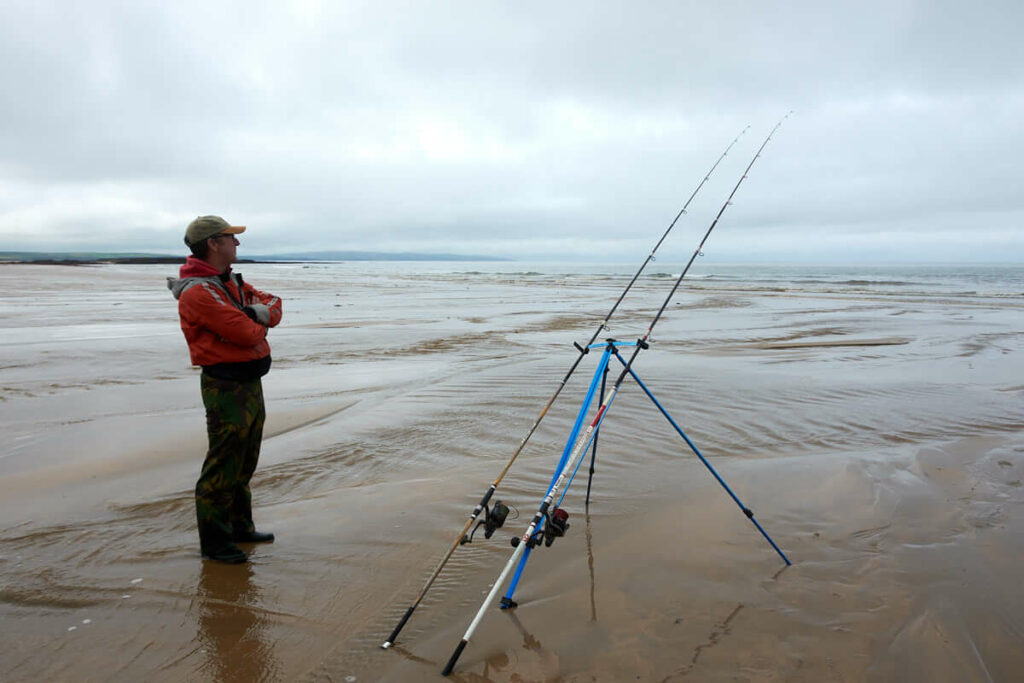
When the dabs are relatively close, consider dropping to a bass rod about 11ft 6in rated 2-4ozs coupled with a 6500 or 550 sized multiplier or a 5000 sized fixed spool reel. Use 12lb mono and a 30lb shock leader on the multiplier with 20lb braid and 40lb braid leader on the fixed spool. 2-3oz leads are ample for this lighter style of fishing.
Dabs like baits anchored to the seabed, so stick with release wired lead weights in all cases. Occasionally, there may be a case when fishing from a pier jetty with open leg construction that allows you to bounce a lighter, plain lead down tide to search out the fish.
An excellent rig for general surfcasting is a clipped up 2-hook rig. Here's how the TFS team build ours...
Clipped up 2-hook rig
For longer range casting a 2-hook clipped up rig is far better and maximises both casting distance and bait presentation at range. Build as follows....
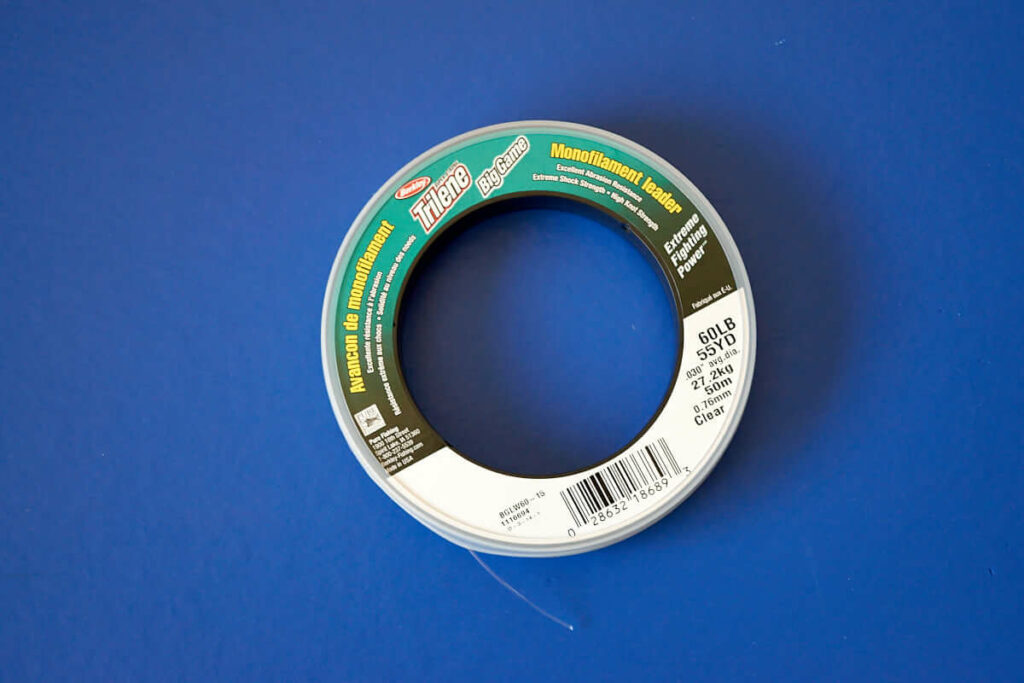
1 - Take a 46-inch length of 60lb rig body line. At one end tie on a Gemini lead link.

2 - Slide on a rig crimp, followed by a 3mm rig bead, a size 10 rolling swivel, and another bead and crimp.

3 - Above these add another crimp, a rig bead and an inverted bait clip, then a rig bead and another crimp.
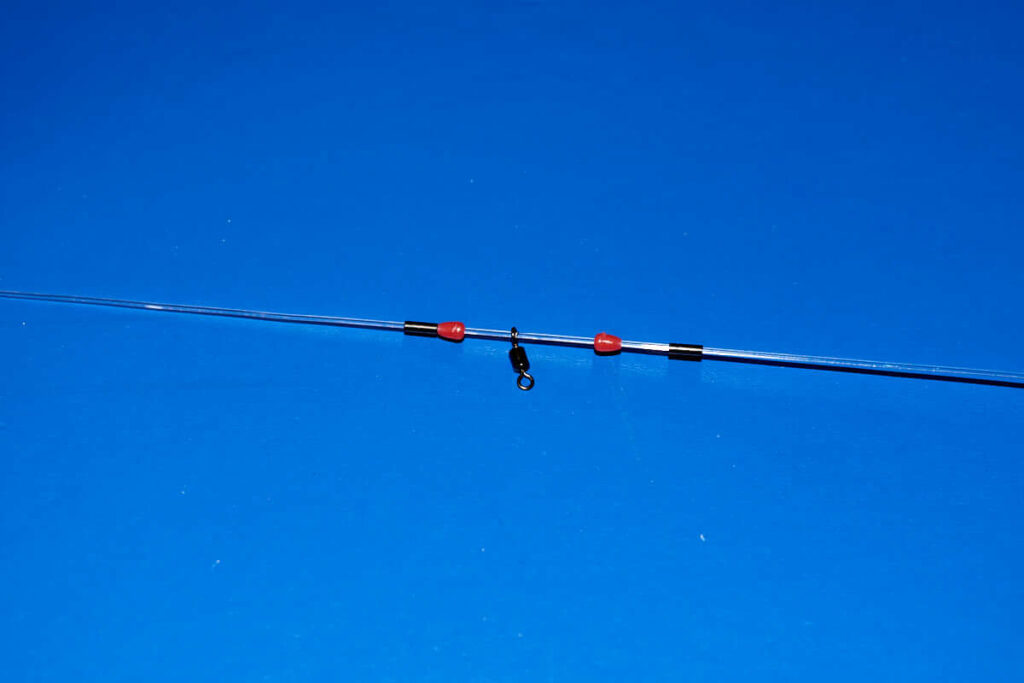
4 - Slide on a rig crimp, followed by a 3mm rig bead, a size 10 rolling swivel, and another bead and crimp.
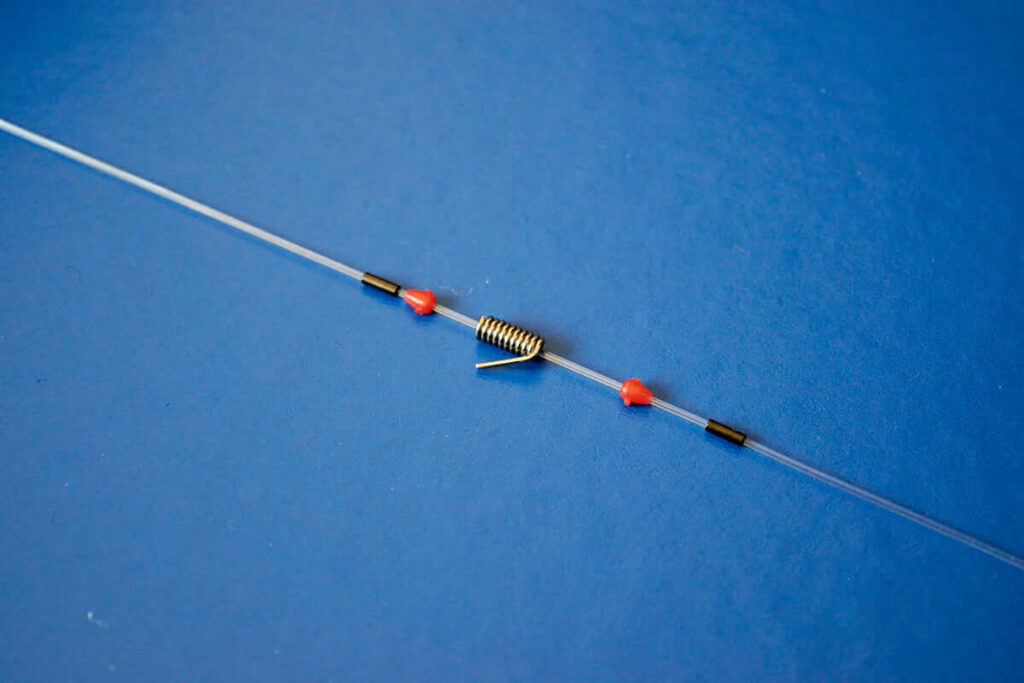
5 - Slide on a crimp, bead and inverted bait clip, plus another bead and crimp. Leave all the above components free to slide on the rig body line for the moment.
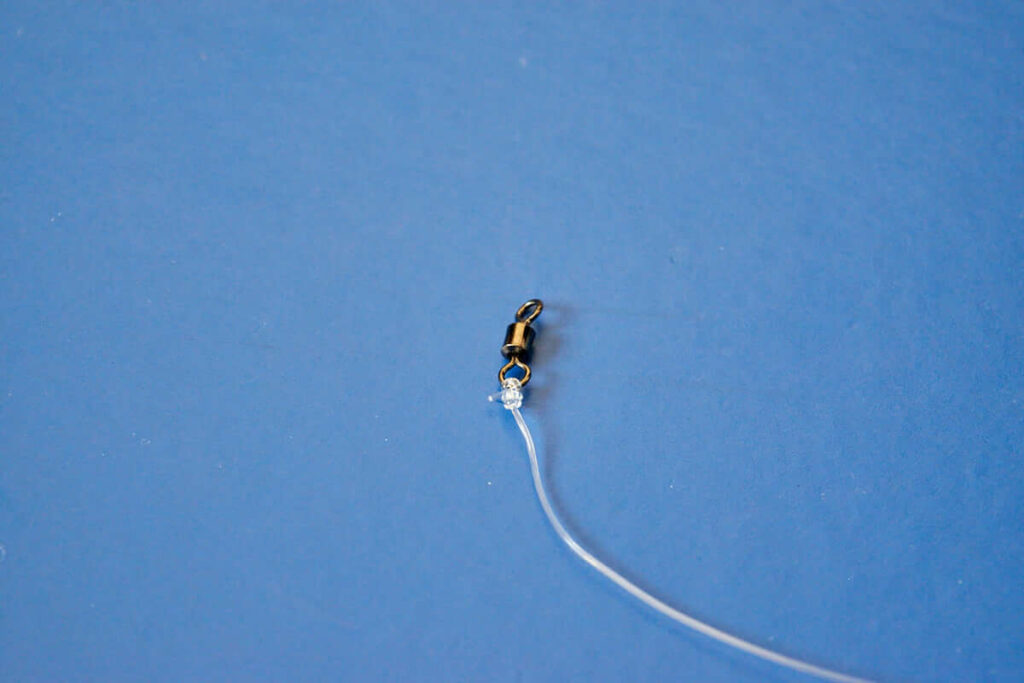
6 - Complete the main rig by adding a size 4 rolling swivel at the top.
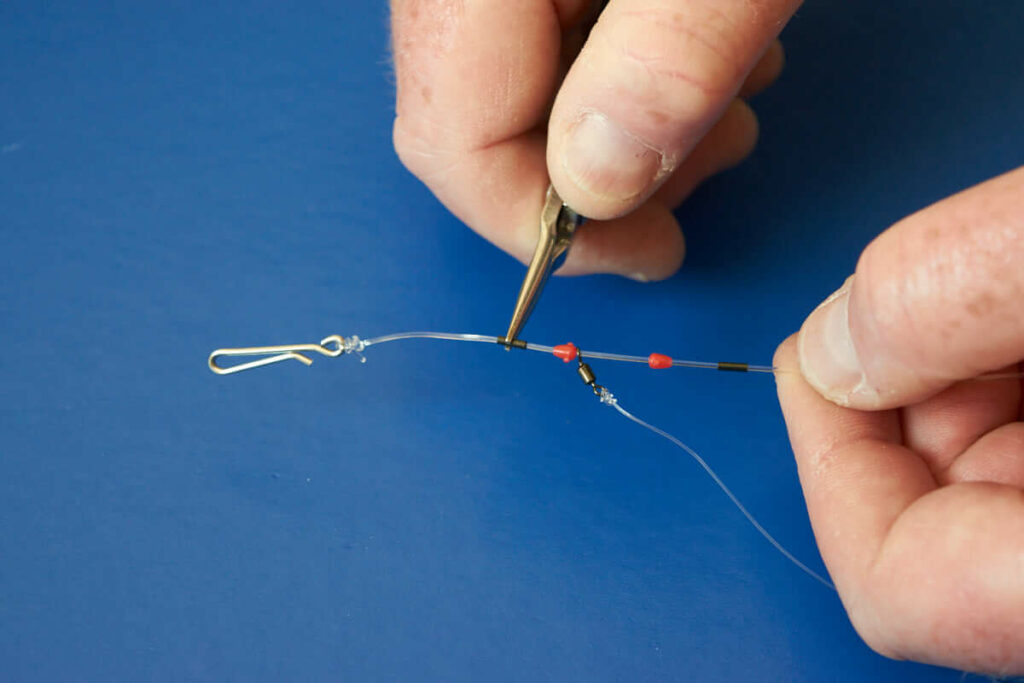
7 - Now crimp the first snood swivel in place 1-inch above the lead link. Leave enough room between the two crimps and beads for the swivel to freely turn.

8 - The hook links need to be 15/20lb mono or Fluorocarbon between 12 and 18 inches long.

9 - Slide on a 5mm rig bead to act as a bait stop, and tie on a size 4 Kamasan B940 Aberdeen hook. Above the 5mm bead tie in a 4-turn Powergum stop knot.

10 - Position the hook in the bait clip and slide the bait clip up the rig until the hook snood comes just tight. Slide the crimp and bead up towards the bait clip and crimp it in place half an inch below the bait clip to allow the clip to slide a little under pressure.
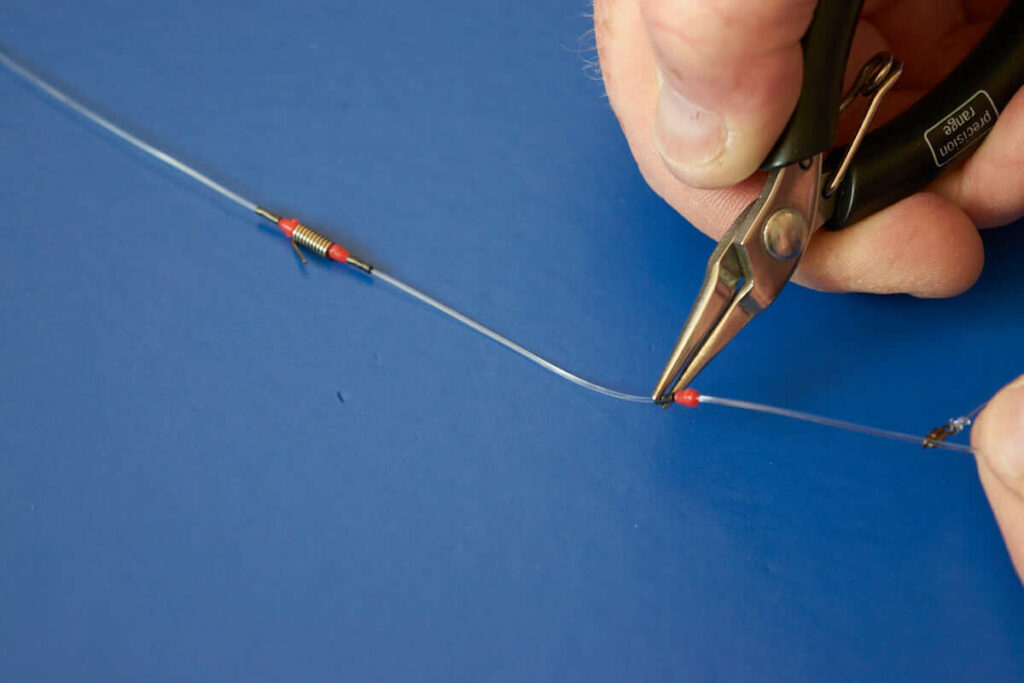
11 - The second snood swivel needs crimping about 3-inches above the first bait clip. Add the hook length and hook with the bead and hook, plus Powergum stop-knot added.
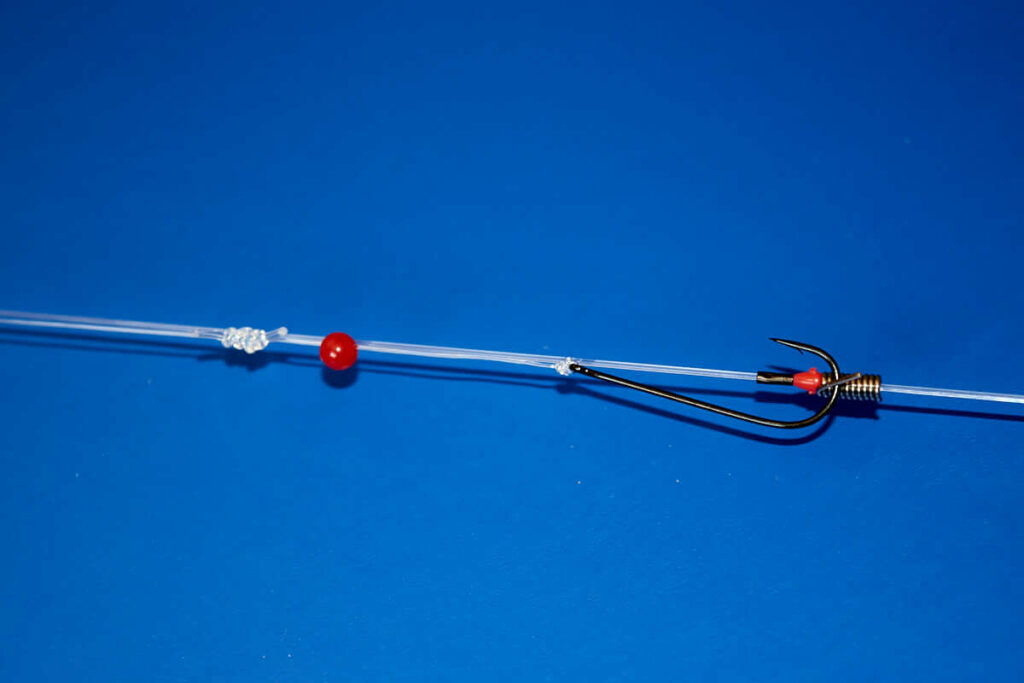
12 - Position the bait clip and crimp in place as before. This positions the top hook inside the bait clip just a couple of inches or so below the main size 4 connector swivel.
There is no real need for bait stops above the hook on this rig as the air pressure during the cast is forcing the bait towards the hook, but it helps give a neater bait presentation, especially when using small delicate ragworm and lug baits.
This rig can put two baits out to maximum range with the hooks clipped in. What's more important is that its design, with the hook snoods clipped up, means air pressure during the cast helps keep the baits intact around the hook with the bait presentation pretty much kept as it was in your hands. This presentation can be important in clear, shallower water, and when competition fishing.
Having the lowest hook link positioned tight behind the lead weight is the best presentation position when targeting flatfish, such as dabs, as the bait is kept tight to the seabed. The higher second hook, though remaining in the flatfish feeding zone, will have a little more movement in the tide and surf tables, and this tends to pick out round fish such as whiting, coalfish, bass and codling as well as dabs.
In calmer seas, the hook links can be lengthened up to 18-inches or more. This gives more natural movement to the baits. However in rougher seas and when fishing in amongst the surf tables, shorter 12-inch hook snoods will tangle less and give feeding dabs a more static target to hit, increasing the catch.
With two hooks fairly close together, this means you are creating, from the two baits, a strong scent trail for the fish to follow up on. This is a major factor when fishing during periods when fish are few and far between, such as February and March when bites are at a premium. For example, fish will follow a strong scent trail in very cold water but may ignore a weak one when feeling comatose in cold seas. Having the strong scent trail also helps to pull fish in from some distance away, where a weaker scent trail reduces the chances.
We keep mentioning this, but it is important. While mono snoods are ok, you will catch more fish if you make the hook snoods from fluorocarbon. In daylight and clear seas, fluorocarbon is less visible to the fish. Also, fluorocarbon is slightly stiffer in character than mono and will tangle less when fishing into surf tables or rougher seas.
3-Hook flapper rig
When casting into deeper water from rocks or man-made structure a better, more efficient rig for multiple catches is a simple 3-hook flapper rig.
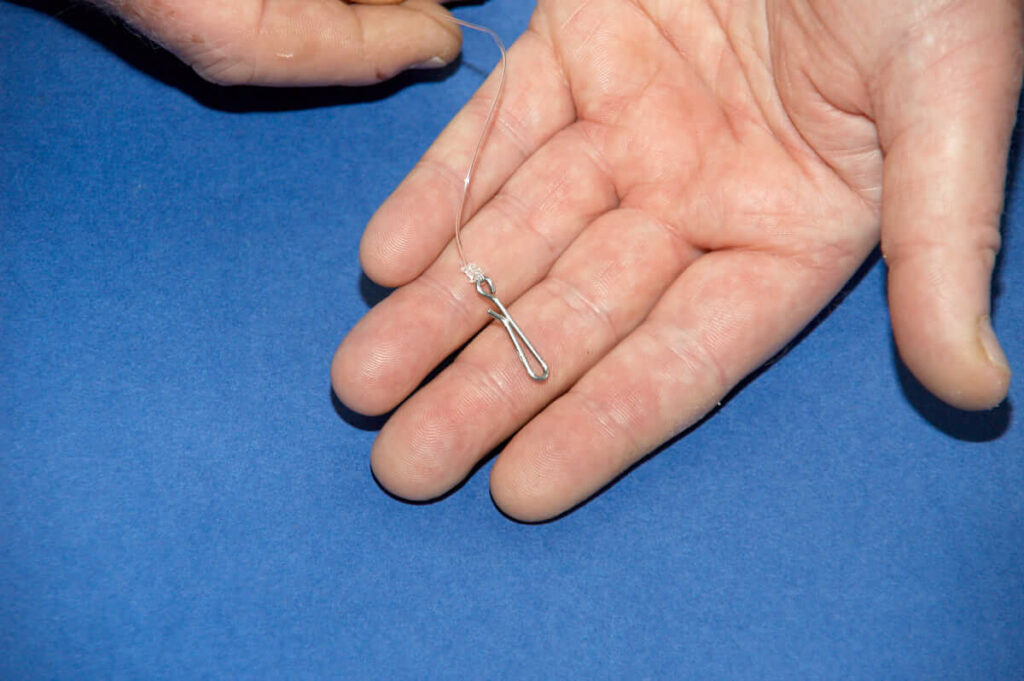
1. Start with about 64-inches of 60lb clear mono. Tie on a Gemini lead link at one end.

2. Slide on a rig crimp, a 3mm oval rig bead, a size 10 swivel, another rig bead and a crimp. Repeat this sequence to give you three full individual sets of crimps, beads and swivels. Leave these loose for now.

3. Complete the rig by tying on an inverted (upside down) Gemini lead link to the tag end of the rig body line.
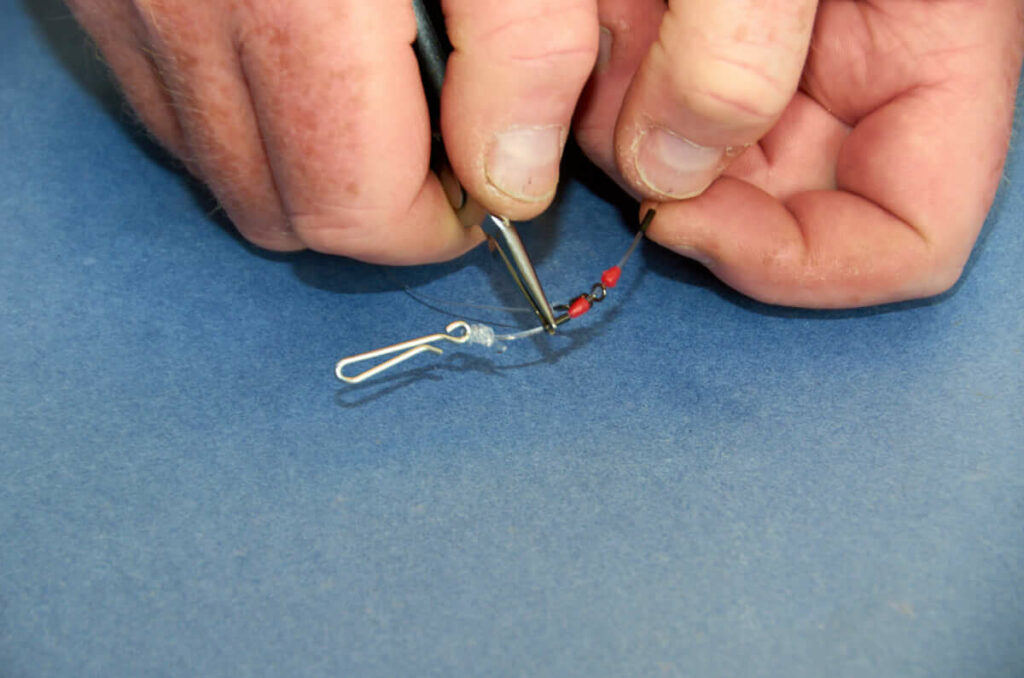
4. The first hook trace swivel needs to be placed just one inch below the top Gemini lead link. The middle swivel should be positioned exactly 17-inches below the top swivel, and the third again 17-inches down from the middle hook trace swivel.
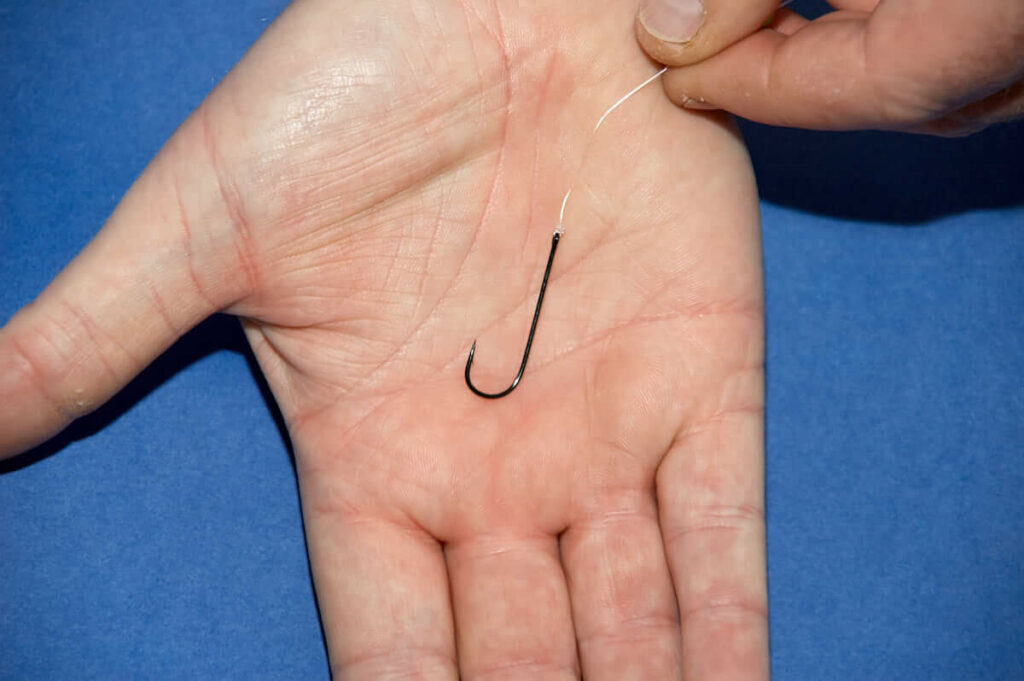
5. The top hook trace needs to be the longest at about 15-inches, the second hook trace measures 13-inches, and the bottom hook trace is the shortest at just 10-inches. All hook traces are made from 20 mono or fluorocarbon and are finished with a size 2 Kamasan B940 hook for general species.
By having a clip link at both ends of the rig body, you can literally reverse this rig around. If all the fish are falling to the bottom hook with the lower hook trace positioned well up above the lead, reverse the rig so that what was the top hook, now fishes tight behind the lead. The middle hook is now positioned where the first one was before you reversed the rig around. This puts two hooks in the feeding zone, giving you the chance to double your catches.
The hook snoods' lengths on this reversible rig are also deliberately tied as different lengths. When fishing to a fairly tight line at close to medium range, the rig's full length will not sit flat on the seabed. Only the bottom hook is fishing hard on the bottom and consistently catching fish. If tied on too short a snood, the other two hooks are suspended up in the water column and less likely to catch.
This rig is tied using a longer top and middle snood. This helps to keep the baits tighter to and in contact with the seabed and inside the main fish-feeding zone, even when the rig body length is lifted by passing surf tables, without the need to fish a slightly slack line between the rod tip and lead weight. The longer snoods also allow the baits to move more naturally.
To ensure you have all the bait's hard on the seabed, release two or three feet of line off the reel and let the line bow down slightly. This minimal slack drops all three baits to the seabed. You'll see the line gently lift as waves or surf tables pass over the line, but bites are far more energetic and obvious when watching for line lifts. This method, especially in calmer seas, is a better way of identifying bites than watching the rod tip is.
Size 4 Kamasan B940's are our go-to hook for dabs, but when fish are not feeding confidently, we prefer to drop to smaller baits and size 6 Aberdeens. This usually works and increases catches. If it doesn't, try reducing the hook lengths' breaking strain down to just 12lbs. This makes the bait behave differently, which can trigger a take when bites are tough to get, even at night.
These little flatties are obliging feeders and will eat a wide variety of baits, but as ever they have their preferences.
They will take a single small-sized blow lug with the sandy tail nipped off then slid down and around the hook tail first to leave the juicy head at the hook end. You can do the same with smaller inch sections of king ragworm.
The best worm bait of all is black lug. It's good fresh cut into short 1-inch to 1.5-inch sections and added to the hook. Better still is gutted black lug left to air dry slightly in damp conditions such as a garage away from vermin. This makes the lug go tacky to the touch and feel like soft liquorice. This is deadly for dabs, especially in the early new year to early spring. Another way to prepare black lug for dabs is to use frozen black lug, but take it out of the freezer the day before you're due to go, and leave it to dry a little. This again makes it go sticky and will pull in the dabs.
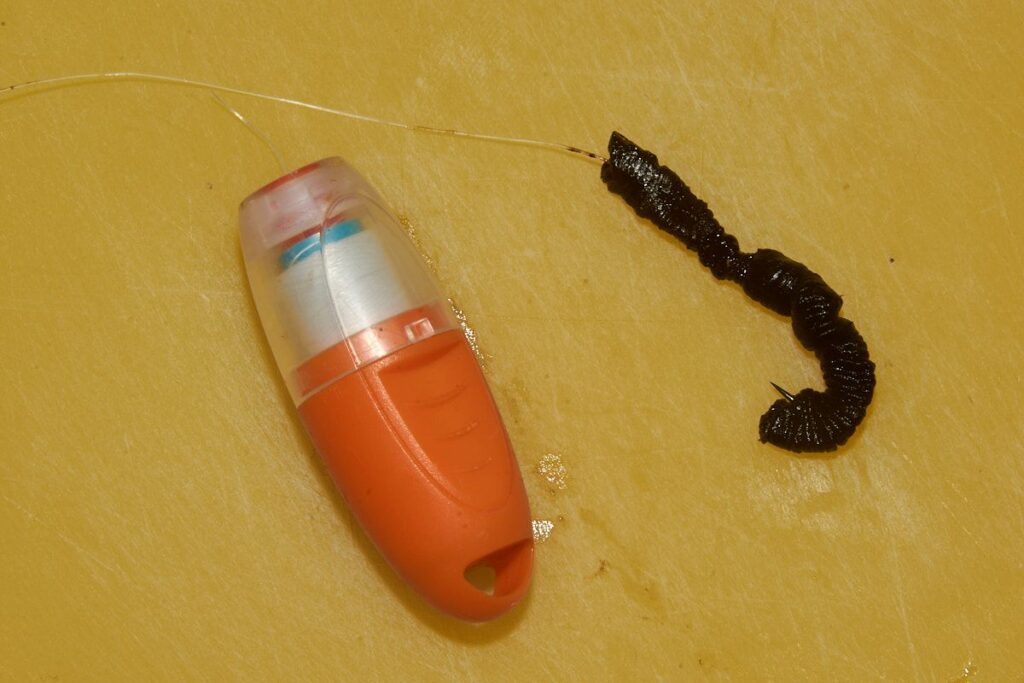
They are also partial to small fish strips such as mackerel, herring or bluey. Cut these about 1.25-inches in length, pass the hook through at the top from the skin side, pull the hook through and pass the hook point back out through the base to expose the point through the skin again. A few light wraps of light bait elastic will hold it there for casting. Strips or small sections of sandeel also work. In the post-Christmas period, try small strips of sprat if you can get it. It's deadly!
This may seem a bit strange, but a good bait in coloured water is strips of kipper, yes the same ones that come in a packet with a notch of butter. Cut them into strips and secure well with bait elastic. If you don't believe us, try it!
They will also take small shellfish baits such as single mussels, sand clam sometimes called butterfish or tellins, and cockles, especially chunks of queen cockle that wash up on the beaches after a blow.
On the shallow surf beaches, it pays to fish two rods casting one to medium range and the other to maximum range. Gradually bring the two closer together until you find the main feeding band. This can often be quite a defined distance when the dabs are advancing inwards with the tide. If you keep casting to say maximum range all the time you can often initially hit the fish, then lose them again as they come closer in. When the rod at medium range starts to find the fish, it's a sign to drop the longer-range rod closer to maximise your catches.
During the neap tides, fish from low water up and the longer you can reach the mean low water line where the dabs hold up in the deeper water, the better the chances of a catch. Once the depth increases over the whole beach and the dabs disperse over more ground, you need to cast closer and fish that middle ground which typically stays productive throughout the rest of the tide.
Also bear in mind those features we discussed such as gutters and any small series of shallow sandbanks or depressions. Fishing anywhere where there is even a small feature will give your chances of a catch a real boost.
When fishing beaches inside small bays that are flanked by rocky headlands, something to bear in mind is that if the day is bright, then try and fish in the shadow of the cliffs. The dabs will move into the shadows thrown by the cliffs during bright conditions. This simple tactic once saw one of the TSF team fishing Keem Strand in Achill, Ireland, pick up a few dabs on a day when other anglers fishing with him all blanked!
It's the same regarding the use of two rods when fishing from any man-made structure. Don't just drop the baits over and see what happens. Use two rods and stagger the casts again. This enables you to find where the fish are concentrated. Also, try to fan the casts out a little to spread the search area to find those hotspots. As the depth increases, the dabs may again move closer and be found almost tight into the structure, especially if the tide is pushing on that side and bringing food that will deposit at the base of the structure.
On steep-to beaches where the depth is greater, the fish will likely be well spread, so using the two rod approach also makes sense. Some dabs will move in closer but expect the fish to be well spread over much of the ground in front of you. The same applies to fishing over sand off rock ledges.
If you're getting lots of bites but not hooking many fish, remember to drop the hook and bait size. This can make a massive difference, especially after prolonged periods of calm settled weather when even the dabs become lethargic.
Dab bites are a series of small but obvious rattles. This is the fish trying to cram the bait in its mouth. Leave the fish for two or three series of rattles to make sure they have the bait in their mouth, then lift into them to set the hook.
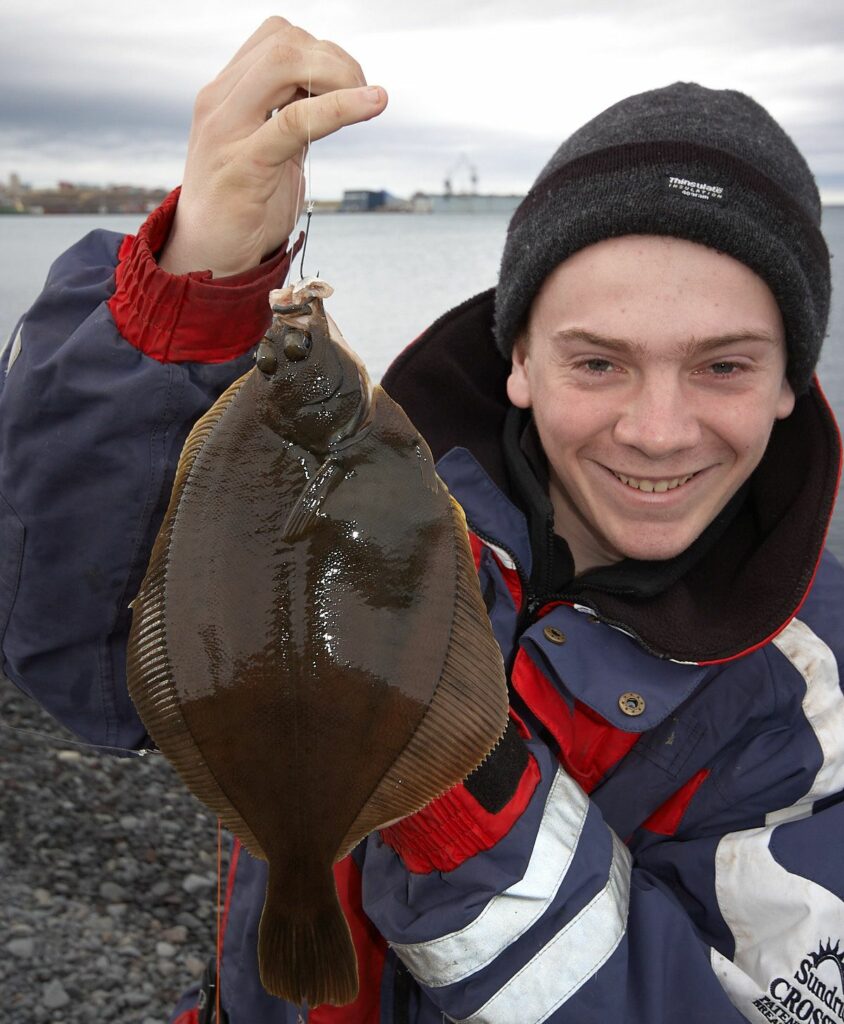
The dab season is pretty much all year round from a boat, though inshore their numbers will drop from mid-March through to August when they begin to move back inshore again after spawning. However, you'll have to wait until those sea temperatures start to cool come October for their numbers to build.

Tide size matters little, be it a small neap or big spring, the dabs will feed on most tides. They do though, like a little tide run, so expect the middle hours of the tide to be the best with bites falling away either side of slack water.
On the inshore shallows to around 40-feet deep, after prolonged heavy seas, expect the fish to have moved out into deeper water less affected by heavy swells. It will take a few tides for the fish to return.
They can be caught in bright daylight, but as we've seen with other species, the more cloudy overcast days prove to be the more productive, especially if there is some surface agitation from a light wind that reduces the light levels entering the water column.
In water over roughly 40-feet, the fish won't travel too far during prolonged low-pressure systems, and their numbers retain a high number throughout.
If you're fishing in an area where tide flow is light, and using leads of 4ozs or less, then a soft-tipped 6lb class boat rod about 8ft in length with a small baitcaster type multiplier loaded with 15lb braid and a short 20lb fluorocarbon leader gives good sport. You can swap the multiplier for a 4000 fixed spool, again loaded with 15lb braid. This combination is perfect for general fishing. Only go heavier if faster tides dictate heavier leads to maintain contact with the seabed.
Light 8ft spinning rods work well with a light 3000 sized fixed spool loaded either with 8lb mono or 12lb braid. Some experienced anglers use an LRF or HRF rod and a small 2000 sized fixed spool with 6lb line, and this proves ideal when fishing small 1oz leads and targeting single dabs on a short flowing trace rig. These outfits are ideal for fishing small bays and water less than 50-feet deep.
The most successful rig we've found to target boat dabs is a flowing trace rig. We like to use a boom to reduce the chances of tangling and help present the baits more naturally.
2-Hook boom rig
The best boom to use is one of the 8 to 10-inch twisted wire type that allows the line to be fed through the hollow T shape body of the boom and has a small swivel at the end of the boom. These will spin and turn on the rig body line and minimise potential tangles. Plastic booms work well too, but the metal is heavier and helps to keep the baits tight to the seabed.
The boom, although being secured between sliding stop knots or rig stops, is best fished for dabs when positioned tight behind the lead weight. This ensures the baits are tight on the bottom and keeps them moving across the sand in a natural manner where the dabs expect to find their food.
Being able to turn freely on the rig body means that even when descending through the water column, there is minimal chance of the trace tangling, especially as the trace is kept deliberately short. It also minimises the chance of tangles if you choose to use a light lead to occasionally bounce the tackle further downtide with the tide current.
Why specifically a wire boom? The wire boom does not flex as it drops through the water column, reducing the chance of the trace tangling. Also, the extra weight of a wire boom helps the baits to stay on the seabed when the line between the weight and the rod tip is allowed to fish just slack. Competition anglers using this type of boom will often fill the triangular hole created where the T shape meets the actual boom with flattened lead. Some will add lead wire or clip on large split shot to the end of the boom behind the swivel to increase this weight further to combat running tide conditions. This affects a dramatic increase in catches of dabs at this time by keeping the bait hard on the sand and an easier target for the dabs to hit.
Using fluorocarbon hook trace material instead of clear mono reduces the chance of tangling as the fluorocarbon is slightly stiffer in character and tangles less when swirled about in the tide. Plus it offers greater abrasion resistance when catching large numbers of fish on the same rig.
Another little tip with this rig is that when fishing in deep water, or slightly coloured water or low light conditions, by adding a single 3mm luminous green bead directly behind the hook, you can double or even triple your catch of dabs. Just the one bead mind, as two seems overkill.
Shrimp rig
This rig incorporates the small shrimp feather rigs with a luminous body. They are typically tied on small size 6 to 8 hooks, making them ideal for dabs. They need to be baited to be effective.
This rig is designed to allow the shrimp rig to sweep over the seabed and cover as much ground as possible. It incorporates a boom, with a normally attached weight on the booms lead clip, to control the long shrimp rig, but the boom is not enough on its own. By attaching a small ball weight to the freer end of the shrimp rig, the rig becomes controllable and predictable in how it works over the ground.
The lead weight avoids tangles by keeping the shrimp rig stretched out, but more importantly, being a round ball weight, it gives the shrimp rig the freedom to roll around adding movement and covering more ground. With leads on both the boom and the end of the shrimp rig, the rig can be fished when at anchor as it will rarely tangle. It is also effective when drift fishing because all four or five hooks are dragging on the seabed where the majority of fish are feeding.
The idea is to bait the hooks with tiny slivers of mackerel, squid, rag or lugworm. With all five hooks baited, this gives a wide scent trail and allows the use of different baits to attract different species.
Although this rig can be deadly in clear, even shallow water conditions, it comes into its own in deep water where light levels are minimal, or in water that still carries some colour after recent turbulence. The luminous glow of the shrimp bodies and the scent from the baits combine to draw fish in, but with the shrimps able to move in the tide, the luminous glow is enhanced due to movement.
Some anglers also choose leads that have a luminous coating applied. This produces a much bigger glowing target area when fishing very deep or semi coloured water that can dramatically increase catches.
Baits are much the same as for shore fishing, though the strips of mackerel, sandeel and herring become the number one bait, with worm baits being pushed down the list a little when fishing offshore.

There is no need to secure fish strips with bait elastic when offshore. If you cut the fish strips to length, typically no more than 1.5-inches, just pass the hook point through from the flesh side and exit the point out through the skin. This leaves the rest of the strip to flutter and move in the water giving a natural presentation.
Keep worm baits small too, just enough to fill the hook. Black lug and blow lug are more effective offshore than ragworm.
Dab fishing offshore is pretty simple at anchor with the bait being fished hard on the seabed and letting any scent from the bait trickle off downtide to find the fish which will follow it up. Bites are rapid rattles on the rod tip. Respond by lifting into the fish after the second series of rattles.
You can adopt a more seek and search approach by utilising one of the Tipster/Continental boat type rods with a fixed spool reel and plain lead weight and casting the baits uptide then letting them trickle back downtide to cover a wide span of ground. This works best if the tide flow is light and the lead travels slow. The bait and weight move too quickly in faster tides, and the fish can't intercept the baits. This works best when your boat fishing position is on one of the gunnels.

When fishing the boat's stern, try casting straight down tide and fish to a tight line feeling for bites. Alternatively, drop down the plain lead weight size until you can lift the rod tip to a tight line, then release a little free line to allow the leads to bounce off downtide and again cover more ground. This latter tactic can be deadly in gentle to medium tide flows.
When drift fishing, make sure you release plenty of line so that you're fishing with a shallow line angle as it enters the water. Every 30 seconds release a few feet of line. This lets the baits settle and stay on the seabed momentarily, which gives the dabs time to seek out and take the bait.
Bites are as before, just a short series of rattles and the fish will normally take the bait into their mouths if given a little time. No more than 30-seconds is about right as it avoids the fish taking the bait too far in causing deep hooking.
About dabs
Although a common catch generally being found in good numbers, dabs are almost a forgotten species for most sea anglers with most classed as an accidental catch. Though a blank saver at worst, they can also provide consistent sport, if properly targeted, when other bites are few and far between.
Dabs commercially, were, until relatively recently, classed as an unwanted catch by trawlers and mostly thrown overboard, or used as pot bait by crab and lobster fisherman. Then came the celebrity chefs in the 1990s and early 2000s who publicised the dab as a food fish noted for its delicate flesh, thus creating a small but flourishing market for the species that remains today. Dabs have, though, been part of the UK's population diet for thousands of years with the Vikings known to have eaten dabs in large numbers.
Dab identification
The dab is a right-sided flatfish with a moderately sized head but a small, concise mouth. It has a defined lateral line that can be seen to curve sharply above the pectoral fin on the eyed side. On the eye side, the skin, if rubbed against the grain, can be felt to be rough. On the belly side, only the edges have this roughness.
By colour, the dab is very obviously different from that of the plaice and flounder, being bronze or light to medium brown on the eye side with small but distinct yellow to gold freckles or stars and a white belly. It is only really likely to be mismatched when in deeper water far offshore where smaller flatfish such as witch and megrim might be caught. However, the dab has a more rounded body than both these that have longer more oval bodies.
They are a small fish rarely growing above 1lb 8ozs, though fish between 2 and 3lbs are possible, especially when fishing lesser fished areas in deeper water off Scotland, Orkney, The Faroes or Shetland. From a sea fishing point of view, any dab of 1lb 4oz or more can be classed as a specimen.

Dab distribution
Dabs are found from the Bay of Biscay, right up the coast of Europe and round into northern Norway as far as The Barents Sea. They are also found throughout Iceland, also in a small pocket mid-way between the Faroes and Iceland.
They are found all around the UK and Ireland but are especially common inside the North Sea and the Irish Sea and off the Donegal coast in Southern Ireland and the deeper water off the Northern Irish coast.
It spawns during the spring and early summer. The eggs and larvae are free-swimming in the upper water column, but once they reach a length between 13mm and 18mm, they revert to life hard on the seabed. The males become sexually mature at 2-years and the females at 3-years. They can live for up to 12-years, though this depends on ideal conditions.
Dab habitat
The dab loves clean sandy or mixed sand and muddy ground. They can be found in just a few feet of water off a shallow sandy surf beach, on sand patches amongst more broken ground, also inside harbours and at the mouths of smaller estuaries. They are often caught from man-made structures such as piers and breakwaters where the water is slightly deeper.
Again, offshore they like the clean sandy ground, but will occasionally be found on areas where fine gravel or shell grit collects. They are found down to depths exceeding 400-feet.
Dab diet
Offshore the diet is mainly small shrimps, worms, small crustaceans and molluscs. Inshore the diet is slightly different with lug and ragworm forming part of its diet, also sand clam and mussel when available, razorfish, and also small peeling crabs.
The dab is also predatory and will take small prey fish such as small sandeels, whitebait and even other juvenile flatfish such as postage-stamp-sized flounder when working the surf tables.
Shore dab fishing
Season
Smaller dabs can be caught throughout the year, but these are hand-sized juveniles. Once the adult dabs complete spawning, usually by late June, they will slowly filter back inshore. They can be caught off the deeper rock ledges and man-made structures, even deeper steep-to beaches but they won't enter the shallow water off surf beaches until the water temperature goes past its peak. This usually occurs in late September or early October. In fact, they are like the whiting, and this inshore migration begins when the first really cold nights occur and especially so if it's frosty.
As November arrives and sea temperatures are dropping their numbers increase steadily, and they will peak in numbers in this shallower water in January to mid-February. This is when water temperatures reach their coldest, so once the sea starts to gradually warm, they will move off through March unless it's a colder than usual end to winter and early spring. Occasionally, a few of the bigger adults will linger inshore around the mouths of estuaries through April and into early May, but this habit is not common.

Tides
Dabs don't care too much about the tides' size when feeding in deeper water, say over 15-feet. They will stay in this depth on most tides and feed consistently throughout the flood and ebb, though less so on the ebb. This especially applies to rock ledges, piers and breakwaters.
On the shallower surf beach, it's different. The neap tides can often produce the best catches simply because when you fish the low water line, you're reaching fish that have stayed put on that ground with no need to push further back out. This tends to concentrate them in numbers. As soon as the tide begins to move, you'll start picking up bites, but these will gather pace as the tide starts to push through the middle hours of the tide, then bites ease as it approaches high water.
On the bigger spring tides, expect the fish to arrive more towards the mid-tide period when the tide is flowing but be more widely spread. They will feed right through the tide, but as soon as the ebb tide starts, they tend to move out quickly and on the shallower beaches may be well out of range.
If the water carries some depth, then daylight is not too much of an issue, but generally speaking, if you can choose a tide that starts to flood in full darkness on the shallower venues, then you'll catch way more dabs.
Habitat
If you fish rock ledges into deeper water, look for the sandy bays that cut deep into the coastline. The tidal flow is lessened here, and the dabs will concentrate inside these areas just off the tide run. The downtide side of a headland that juts out into the sea is always a top spot to fish from.
Inside harbours, they like the slightly deeper channels where passing boat travel has stirred up the sand and mud and dug access channels out. They will also sit on the rising sides of small sandbanks and collect around the anchorage of bigger buoys, probably because of the seed mussels collecting on the anchor chains.
When you're casting into deeper water from piers, breakwaters and jetties, it often happens that there is shallower ground near the structure, but then it deepens as you cast further away. This deeper water where the ground angles deeper is a great spot. A good way to assess where you need to fish is to gradually search the ground in front of you and note where most bites come from over a few sessions. There will be a hotspot, probably a slightly deeper area or depression, or small sandbanks, but this will be enough to keep the fish resident.
On steep-to beaches, try to pinpoint any tidal currents and fish close to these. That said, the dabs will be well spread on these deeper beaches, and it can just be a matter of waiting between bites as fish advance in.
On the shallower surf beaches, you need to find the feature that will hold the dabs once they move in. These features are typically deeper gutters and channels that run parallel with the shore created by wave action and tidal currents. The fish will drop into these and stay there as food washes into these throughout the tide. Other good spots are areas where you can see water holding when the tide is out as these will again concentrate food when the tide refloods them. Also, try casting close to patches of rougher ground or shingle.
Those of you that cast a fair distance, during the neap tides, if you can still reach the low water line where the beach often carries a lifting ledge or bank of sand, then if you can cast past this you can expect some really good catches as the dabs often choose to stay this side of the low water demarcation line and this can concentrate their numbers.

Weather patterns
In water over 40-feet deep, the dabs are not affected by rough seas too much. There is little disturbance in this water depth at ground level so the fish will remain in fair numbers. If the water is under 30-feet deep and the seas are very rough with a big swell, then this will force the fish out to deeper water where they'll stay until conditions improve.
Dabs tend to like calmer more settled seas, especially when living on the shallower marks and beaches. Ideal conditions are a period of relatively calm weather, maybe a frost or two, then they'll move into the beaches in good numbers. They will also be happy in water that remains well coloured after a blow and will feed happily by day in these conditions, but if the water is clear, even with some depth, then you'll do way better by fishing in the dark.
If there is a real breaking surf on shallower beaches, then our experience, even at long range, is that the dabs will not feed and maybe won't even be in range of even the best casters.
Dabs are one fish that will continue to feed even in cold easterly winds and high pressure. Maybe not in the numbers they would if the barometric pressure was lower with a westerly based breeze, but some fish will still feed and keep the rod tips nodding.
Dabs like cooler water, so if there has been a spell of warmer wet weather from the southwest and a sudden shift to calm frosty nights and cold days, look for a tide that is out during the day and floods early evening. The exposed sand retains some of the cold, and this will cool the shallow flooding water further, and this will encourage the dabs tighter inshore.
Tackle
Due to the distance, you need to cast when fishing off rock ledges, piers and breakwaters, and lift fish up some distance; you'll need a standard 12ft to 13ft beachcaster rated to cast 4-6ozs. From man-made structures go for a heavier duty reel such as the Penn 525Mag4's and load with 18lb line and a 60lb shock leader.
On the shallower surf beaches, casting distance becomes much more critical. To achieve maximum range change to a smaller faster running reel such as an Abu 6500 series or the Tronix Guerilla or Akios equivalents. Standard reel line would be 15lb mono, but to get greater range consider going as light as 12lb with a 60lb shock leader. Try it; it makes a big difference to the distance you cast!
Those of you preferring a fixed spool reel should look to a longer 14ft to 15ft 4-6oz rod. Reel size needs to be 7500, ideally with a long cast spool and load with 20lb braid adding an 80lb braid shock leader. This will give you maximum range with just a simple overhead casting style. Lay the lead on the ground and use an off-the-ground style and you'll hit massive ranges.

When the dabs are relatively close, consider dropping to a bass rod about 11ft 6in rated 2-4ozs coupled with a 6500 or 550 sized multiplier or a 5000 sized fixed spool reel. Use 12lb mono and a 30lb shock leader on the multiplier with 20lb braid and 40lb braid leader on the fixed spool. 2-3oz leads are ample for this lighter style of fishing.
Dabs like baits anchored to the seabed, so stick with release wired lead weights in all cases. Occasionally, there may be a case when fishing from a pier jetty with open leg construction that allows you to bounce a lighter, plain lead down tide to search out the fish.
Rigs
An excellent rig for general surfcasting is a clipped up 2-hook rig. Here's how the TFS team build ours...
Clipped up 2-hook rig
For longer range casting a 2-hook clipped up rig is far better and maximises both casting distance and bait presentation at range. Build as follows....

1 - Take a 46-inch length of 60lb rig body line. At one end tie on a Gemini lead link.

2 - Slide on a rig crimp, followed by a 3mm rig bead, a size 10 rolling swivel, and another bead and crimp.

3 - Above these add another crimp, a rig bead and an inverted bait clip, then a rig bead and another crimp.

4 - Slide on a rig crimp, followed by a 3mm rig bead, a size 10 rolling swivel, and another bead and crimp.

5 - Slide on a crimp, bead and inverted bait clip, plus another bead and crimp. Leave all the above components free to slide on the rig body line for the moment.

6 - Complete the main rig by adding a size 4 rolling swivel at the top.

7 - Now crimp the first snood swivel in place 1-inch above the lead link. Leave enough room between the two crimps and beads for the swivel to freely turn.

8 - The hook links need to be 15/20lb mono or Fluorocarbon between 12 and 18 inches long.

9 - Slide on a 5mm rig bead to act as a bait stop, and tie on a size 4 Kamasan B940 Aberdeen hook. Above the 5mm bead tie in a 4-turn Powergum stop knot.

10 - Position the hook in the bait clip and slide the bait clip up the rig until the hook snood comes just tight. Slide the crimp and bead up towards the bait clip and crimp it in place half an inch below the bait clip to allow the clip to slide a little under pressure.

11 - The second snood swivel needs crimping about 3-inches above the first bait clip. Add the hook length and hook with the bead and hook, plus Powergum stop-knot added.

12 - Position the bait clip and crimp in place as before. This positions the top hook inside the bait clip just a couple of inches or so below the main size 4 connector swivel.
There is no real need for bait stops above the hook on this rig as the air pressure during the cast is forcing the bait towards the hook, but it helps give a neater bait presentation, especially when using small delicate ragworm and lug baits.
This rig can put two baits out to maximum range with the hooks clipped in. What's more important is that its design, with the hook snoods clipped up, means air pressure during the cast helps keep the baits intact around the hook with the bait presentation pretty much kept as it was in your hands. This presentation can be important in clear, shallower water, and when competition fishing.
Having the lowest hook link positioned tight behind the lead weight is the best presentation position when targeting flatfish, such as dabs, as the bait is kept tight to the seabed. The higher second hook, though remaining in the flatfish feeding zone, will have a little more movement in the tide and surf tables, and this tends to pick out round fish such as whiting, coalfish, bass and codling as well as dabs.
In calmer seas, the hook links can be lengthened up to 18-inches or more. This gives more natural movement to the baits. However in rougher seas and when fishing in amongst the surf tables, shorter 12-inch hook snoods will tangle less and give feeding dabs a more static target to hit, increasing the catch.
With two hooks fairly close together, this means you are creating, from the two baits, a strong scent trail for the fish to follow up on. This is a major factor when fishing during periods when fish are few and far between, such as February and March when bites are at a premium. For example, fish will follow a strong scent trail in very cold water but may ignore a weak one when feeling comatose in cold seas. Having the strong scent trail also helps to pull fish in from some distance away, where a weaker scent trail reduces the chances.
We keep mentioning this, but it is important. While mono snoods are ok, you will catch more fish if you make the hook snoods from fluorocarbon. In daylight and clear seas, fluorocarbon is less visible to the fish. Also, fluorocarbon is slightly stiffer in character than mono and will tangle less when fishing into surf tables or rougher seas.
3-Hook flapper rig
When casting into deeper water from rocks or man-made structure a better, more efficient rig for multiple catches is a simple 3-hook flapper rig.

1. Start with about 64-inches of 60lb clear mono. Tie on a Gemini lead link at one end.

2. Slide on a rig crimp, a 3mm oval rig bead, a size 10 swivel, another rig bead and a crimp. Repeat this sequence to give you three full individual sets of crimps, beads and swivels. Leave these loose for now.

3. Complete the rig by tying on an inverted (upside down) Gemini lead link to the tag end of the rig body line.

4. The first hook trace swivel needs to be placed just one inch below the top Gemini lead link. The middle swivel should be positioned exactly 17-inches below the top swivel, and the third again 17-inches down from the middle hook trace swivel.

5. The top hook trace needs to be the longest at about 15-inches, the second hook trace measures 13-inches, and the bottom hook trace is the shortest at just 10-inches. All hook traces are made from 20 mono or fluorocarbon and are finished with a size 2 Kamasan B940 hook for general species.
By having a clip link at both ends of the rig body, you can literally reverse this rig around. If all the fish are falling to the bottom hook with the lower hook trace positioned well up above the lead, reverse the rig so that what was the top hook, now fishes tight behind the lead. The middle hook is now positioned where the first one was before you reversed the rig around. This puts two hooks in the feeding zone, giving you the chance to double your catches.
The hook snoods' lengths on this reversible rig are also deliberately tied as different lengths. When fishing to a fairly tight line at close to medium range, the rig's full length will not sit flat on the seabed. Only the bottom hook is fishing hard on the bottom and consistently catching fish. If tied on too short a snood, the other two hooks are suspended up in the water column and less likely to catch.
This rig is tied using a longer top and middle snood. This helps to keep the baits tighter to and in contact with the seabed and inside the main fish-feeding zone, even when the rig body length is lifted by passing surf tables, without the need to fish a slightly slack line between the rod tip and lead weight. The longer snoods also allow the baits to move more naturally.
To ensure you have all the bait's hard on the seabed, release two or three feet of line off the reel and let the line bow down slightly. This minimal slack drops all three baits to the seabed. You'll see the line gently lift as waves or surf tables pass over the line, but bites are far more energetic and obvious when watching for line lifts. This method, especially in calmer seas, is a better way of identifying bites than watching the rod tip is.
Size 4 Kamasan B940's are our go-to hook for dabs, but when fish are not feeding confidently, we prefer to drop to smaller baits and size 6 Aberdeens. This usually works and increases catches. If it doesn't, try reducing the hook lengths' breaking strain down to just 12lbs. This makes the bait behave differently, which can trigger a take when bites are tough to get, even at night.
Baits
These little flatties are obliging feeders and will eat a wide variety of baits, but as ever they have their preferences.
They will take a single small-sized blow lug with the sandy tail nipped off then slid down and around the hook tail first to leave the juicy head at the hook end. You can do the same with smaller inch sections of king ragworm.
The best worm bait of all is black lug. It's good fresh cut into short 1-inch to 1.5-inch sections and added to the hook. Better still is gutted black lug left to air dry slightly in damp conditions such as a garage away from vermin. This makes the lug go tacky to the touch and feel like soft liquorice. This is deadly for dabs, especially in the early new year to early spring. Another way to prepare black lug for dabs is to use frozen black lug, but take it out of the freezer the day before you're due to go, and leave it to dry a little. This again makes it go sticky and will pull in the dabs.

They are also partial to small fish strips such as mackerel, herring or bluey. Cut these about 1.25-inches in length, pass the hook through at the top from the skin side, pull the hook through and pass the hook point back out through the base to expose the point through the skin again. A few light wraps of light bait elastic will hold it there for casting. Strips or small sections of sandeel also work. In the post-Christmas period, try small strips of sprat if you can get it. It's deadly!
This may seem a bit strange, but a good bait in coloured water is strips of kipper, yes the same ones that come in a packet with a notch of butter. Cut them into strips and secure well with bait elastic. If you don't believe us, try it!
They will also take small shellfish baits such as single mussels, sand clam sometimes called butterfish or tellins, and cockles, especially chunks of queen cockle that wash up on the beaches after a blow.
Technique
On the shallow surf beaches, it pays to fish two rods casting one to medium range and the other to maximum range. Gradually bring the two closer together until you find the main feeding band. This can often be quite a defined distance when the dabs are advancing inwards with the tide. If you keep casting to say maximum range all the time you can often initially hit the fish, then lose them again as they come closer in. When the rod at medium range starts to find the fish, it's a sign to drop the longer-range rod closer to maximise your catches.
During the neap tides, fish from low water up and the longer you can reach the mean low water line where the dabs hold up in the deeper water, the better the chances of a catch. Once the depth increases over the whole beach and the dabs disperse over more ground, you need to cast closer and fish that middle ground which typically stays productive throughout the rest of the tide.
Also bear in mind those features we discussed such as gutters and any small series of shallow sandbanks or depressions. Fishing anywhere where there is even a small feature will give your chances of a catch a real boost.
When fishing beaches inside small bays that are flanked by rocky headlands, something to bear in mind is that if the day is bright, then try and fish in the shadow of the cliffs. The dabs will move into the shadows thrown by the cliffs during bright conditions. This simple tactic once saw one of the TSF team fishing Keem Strand in Achill, Ireland, pick up a few dabs on a day when other anglers fishing with him all blanked!
It's the same regarding the use of two rods when fishing from any man-made structure. Don't just drop the baits over and see what happens. Use two rods and stagger the casts again. This enables you to find where the fish are concentrated. Also, try to fan the casts out a little to spread the search area to find those hotspots. As the depth increases, the dabs may again move closer and be found almost tight into the structure, especially if the tide is pushing on that side and bringing food that will deposit at the base of the structure.
On steep-to beaches where the depth is greater, the fish will likely be well spread, so using the two rod approach also makes sense. Some dabs will move in closer but expect the fish to be well spread over much of the ground in front of you. The same applies to fishing over sand off rock ledges.
If you're getting lots of bites but not hooking many fish, remember to drop the hook and bait size. This can make a massive difference, especially after prolonged periods of calm settled weather when even the dabs become lethargic.
Dab bites are a series of small but obvious rattles. This is the fish trying to cram the bait in its mouth. Leave the fish for two or three series of rattles to make sure they have the bait in their mouth, then lift into them to set the hook.

Top tips for dab fishing from the shore
- A simple but vital tip to catch more dabs is to use small baits and small hooks, the hooks no bigger than a size 4 Aberdeen. Too many anglers use baits that are far too big for a dab's small mouth and pay the price in low catches. Stick to the size of baits we suggested in the bait section, small hooks, and you'll catch your share.
- In coloured seas and especially at night, try adding a single small luminous green bead just above the hook. Make sure you charge this in your headlight or UV torch before casting to make it more effective.
- We've noticed that nights with no moon fish way better on shallow beaches than when there's bright moonlight. Bear this in mind when choosing times to fish, especially if the seas have been very settled for a long period.
Boat dab fishing
Season
The dab season is pretty much all year round from a boat, though inshore their numbers will drop from mid-March through to August when they begin to move back inshore again after spawning. However, you'll have to wait until those sea temperatures start to cool come October for their numbers to build.

Tides
Tide size matters little, be it a small neap or big spring, the dabs will feed on most tides. They do though, like a little tide run, so expect the middle hours of the tide to be the best with bites falling away either side of slack water.
Weather patterns
On the inshore shallows to around 40-feet deep, after prolonged heavy seas, expect the fish to have moved out into deeper water less affected by heavy swells. It will take a few tides for the fish to return.
They can be caught in bright daylight, but as we've seen with other species, the more cloudy overcast days prove to be the more productive, especially if there is some surface agitation from a light wind that reduces the light levels entering the water column.
In water over roughly 40-feet, the fish won't travel too far during prolonged low-pressure systems, and their numbers retain a high number throughout.
Tackle
If you're fishing in an area where tide flow is light, and using leads of 4ozs or less, then a soft-tipped 6lb class boat rod about 8ft in length with a small baitcaster type multiplier loaded with 15lb braid and a short 20lb fluorocarbon leader gives good sport. You can swap the multiplier for a 4000 fixed spool, again loaded with 15lb braid. This combination is perfect for general fishing. Only go heavier if faster tides dictate heavier leads to maintain contact with the seabed.
Light 8ft spinning rods work well with a light 3000 sized fixed spool loaded either with 8lb mono or 12lb braid. Some experienced anglers use an LRF or HRF rod and a small 2000 sized fixed spool with 6lb line, and this proves ideal when fishing small 1oz leads and targeting single dabs on a short flowing trace rig. These outfits are ideal for fishing small bays and water less than 50-feet deep.
Rigs
The most successful rig we've found to target boat dabs is a flowing trace rig. We like to use a boom to reduce the chances of tangling and help present the baits more naturally.
2-Hook boom rig
The best boom to use is one of the 8 to 10-inch twisted wire type that allows the line to be fed through the hollow T shape body of the boom and has a small swivel at the end of the boom. These will spin and turn on the rig body line and minimise potential tangles. Plastic booms work well too, but the metal is heavier and helps to keep the baits tight to the seabed.
- Begin with 18-inches of 40lb clear mono.
- To one end tie on a size 4 rolling swivel.
- Using a short section of 20lb Powergum, tie in a 5-turn Grinner knot over the rig body line to act as a stop knot.
- Now slide on a 5mm bead, followed by the boom and another 5mm bead.
- Tie in another Powergum stop knot.
- To the free end of line tie on a size 2 French snap link to take the lead weight.
- To form the hook trace, take 30-inches of 15/20lb Fluorocarbon and tie one end to the boom swivel.
- Form a 12-inch loop in the free end of the hook length. Tie in a figure-of-eight knot to secure the 15-inch loop.
- Create a short 6-inch hook length by cutting one side of the loop 6-inches below the figure-of-eight knot. This also creates a second lower hook length about 18-inches long.
- To both the short and long hook lengths created by cutting the loop, tie on a size 4 Kamasan B940 Aberdeen hook.
The boom, although being secured between sliding stop knots or rig stops, is best fished for dabs when positioned tight behind the lead weight. This ensures the baits are tight on the bottom and keeps them moving across the sand in a natural manner where the dabs expect to find their food.
Being able to turn freely on the rig body means that even when descending through the water column, there is minimal chance of the trace tangling, especially as the trace is kept deliberately short. It also minimises the chance of tangles if you choose to use a light lead to occasionally bounce the tackle further downtide with the tide current.
Why specifically a wire boom? The wire boom does not flex as it drops through the water column, reducing the chance of the trace tangling. Also, the extra weight of a wire boom helps the baits to stay on the seabed when the line between the weight and the rod tip is allowed to fish just slack. Competition anglers using this type of boom will often fill the triangular hole created where the T shape meets the actual boom with flattened lead. Some will add lead wire or clip on large split shot to the end of the boom behind the swivel to increase this weight further to combat running tide conditions. This affects a dramatic increase in catches of dabs at this time by keeping the bait hard on the sand and an easier target for the dabs to hit.
Using fluorocarbon hook trace material instead of clear mono reduces the chance of tangling as the fluorocarbon is slightly stiffer in character and tangles less when swirled about in the tide. Plus it offers greater abrasion resistance when catching large numbers of fish on the same rig.
Another little tip with this rig is that when fishing in deep water, or slightly coloured water or low light conditions, by adding a single 3mm luminous green bead directly behind the hook, you can double or even triple your catch of dabs. Just the one bead mind, as two seems overkill.
Shrimp rig
This rig incorporates the small shrimp feather rigs with a luminous body. They are typically tied on small size 6 to 8 hooks, making them ideal for dabs. They need to be baited to be effective.
- Start with 30-inches of 60lb clear mono line.
- At one end tie on a size 4 rolling swivel.
- Slide on a 5mm bead, a 10-inch hollow plastic boom, followed by a 5mm bead.
- To the free end of line tie on a size 4 rolling swivel.
- Tie one end of the Shrimp rig to the lower swivel.
- To the free end of the shrimp rig tie on a Gemini lead link. This takes a small lead around 0.25 to 0.5oz weight to keep the rig from tangling.
This rig is designed to allow the shrimp rig to sweep over the seabed and cover as much ground as possible. It incorporates a boom, with a normally attached weight on the booms lead clip, to control the long shrimp rig, but the boom is not enough on its own. By attaching a small ball weight to the freer end of the shrimp rig, the rig becomes controllable and predictable in how it works over the ground.
The lead weight avoids tangles by keeping the shrimp rig stretched out, but more importantly, being a round ball weight, it gives the shrimp rig the freedom to roll around adding movement and covering more ground. With leads on both the boom and the end of the shrimp rig, the rig can be fished when at anchor as it will rarely tangle. It is also effective when drift fishing because all four or five hooks are dragging on the seabed where the majority of fish are feeding.
The idea is to bait the hooks with tiny slivers of mackerel, squid, rag or lugworm. With all five hooks baited, this gives a wide scent trail and allows the use of different baits to attract different species.
Although this rig can be deadly in clear, even shallow water conditions, it comes into its own in deep water where light levels are minimal, or in water that still carries some colour after recent turbulence. The luminous glow of the shrimp bodies and the scent from the baits combine to draw fish in, but with the shrimps able to move in the tide, the luminous glow is enhanced due to movement.
Some anglers also choose leads that have a luminous coating applied. This produces a much bigger glowing target area when fishing very deep or semi coloured water that can dramatically increase catches.
Baits
Baits are much the same as for shore fishing, though the strips of mackerel, sandeel and herring become the number one bait, with worm baits being pushed down the list a little when fishing offshore.

There is no need to secure fish strips with bait elastic when offshore. If you cut the fish strips to length, typically no more than 1.5-inches, just pass the hook point through from the flesh side and exit the point out through the skin. This leaves the rest of the strip to flutter and move in the water giving a natural presentation.
Keep worm baits small too, just enough to fill the hook. Black lug and blow lug are more effective offshore than ragworm.
Technique
Dab fishing offshore is pretty simple at anchor with the bait being fished hard on the seabed and letting any scent from the bait trickle off downtide to find the fish which will follow it up. Bites are rapid rattles on the rod tip. Respond by lifting into the fish after the second series of rattles.
You can adopt a more seek and search approach by utilising one of the Tipster/Continental boat type rods with a fixed spool reel and plain lead weight and casting the baits uptide then letting them trickle back downtide to cover a wide span of ground. This works best if the tide flow is light and the lead travels slow. The bait and weight move too quickly in faster tides, and the fish can't intercept the baits. This works best when your boat fishing position is on one of the gunnels.

When fishing the boat's stern, try casting straight down tide and fish to a tight line feeling for bites. Alternatively, drop down the plain lead weight size until you can lift the rod tip to a tight line, then release a little free line to allow the leads to bounce off downtide and again cover more ground. This latter tactic can be deadly in gentle to medium tide flows.
When drift fishing, make sure you release plenty of line so that you're fishing with a shallow line angle as it enters the water. Every 30 seconds release a few feet of line. This lets the baits settle and stay on the seabed momentarily, which gives the dabs time to seek out and take the bait.
Bites are as before, just a short series of rattles and the fish will normally take the bait into their mouths if given a little time. No more than 30-seconds is about right as it avoids the fish taking the bait too far in causing deep hooking.
Top tips for dab fishing from a boat
- If bites are proving tough to get, reduce the hook's size to a 6 or 8 and drop the bait size accordingly. Also, reduce the hook trace's diameter to say 15lbs or even 10lbs. This gives the bait a little more natural movement and helps the baits to flow out over the seabed better, which can induce more bites.
- In deeper water or water carrying a hint of colour, adding a luminous green lead weight to the rig can make a huge difference. Green is by far the best colour and when sat on the seabed after a good light charge will illuminate well and act as a draw for the dabs which are inquisitive and will home in on it to see what's going on. Getting the fish near the baits increases your chances of one taking it.
- Dabs love a bait that rises up then falls back to the seabed. They take as soon as the bait hits the seabed. Induce this by gently lifting up the rod tip, just a couple of feet, enough to lift the baits off the seabed then drop them back.

